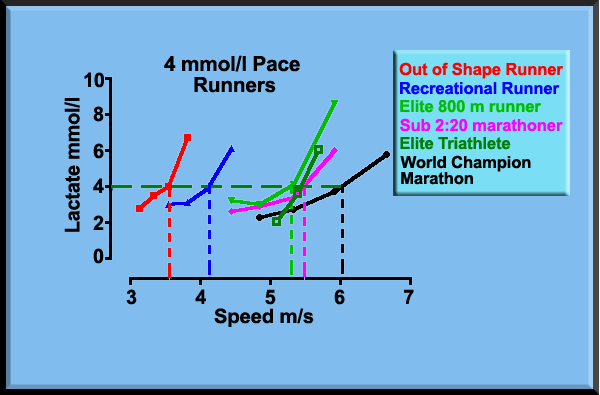Endurance Events and Lactate Testing
With Emphasis on the Triathlon
7 of 19
A Framework for Triathlete Testing
The following four modules discuss the information objectives of lactate testing for triathletes, different types of lactate tests, priorities for testing, and protocols recommended for recreational, serious and elite competitors.
Lactate Tests - Information Objectives
Since the main objectives of lactate testing involve evaluating training and developing training plans, tests should be done in the training environment. Field tests are preferred where possible (see the modules on Consistent Testing.) The influence of seasonal weather changes should be part of the analysis of the tests.
The main objective of a lactate test protocol is to obtain information on the strength of aerobic and anaerobic energy delivery. This can be done very generally, or very precisely with great detail. The better the athlete the more care is needed. A very simple test can give an initial assessment of the aerobic or anaerobic strength of an athlete. This is very useful for recreational triathletes, as they often have little understanding of their conditioning levels. An example of a very easy way to obtain the first indication of the strength of the aerobic energy system is to clock the speed at 4 mmol/l lactate using an effort of at least 4 minutes but preferably a little longer (swimming 400m, running 1200m, cycling 3000m). The better the performance level of the athlete and the more time she/he can spend on training and the more precise and detailed the information must be for the aerobic and anaerobic characteristics of the energy delivery. For example here are the 4 mmol/l running speeds of various levels of athletes.

The red line indicates a former good college runner who is out of shape and interested in competing again in triathlons. The blue line is a good recreational runner. The black line was the world champion in the marathon near the time this lactate test was taken. Today's marathon world record holder would be further to the right. The pink line is that of a sub 2:20 marathoner. The dark green line almost at the same place as the pink line is an elite triathlete, probably one of the best in the world. The light green line is a world class 800 m runner who competed in the Olympics.
A properly designed lactate test protocol can provide measures of all the following attributes of an athlete:
- Aerobic capacity - the maximal or organic potential for oxygen uptake of an athlete
- Aerobic power - the extent to which the aerobic capacity can be exploited for sustained effort
- Anaerobic capacity - the maximal or organic potential to produce pyruvate or lactate
- Anaerobic power - the extent to which the anaerobic capacity can be exploited for sustained effort
The last metabolic parameter, anaerobic power, is of very low interest for a triathlete. Anaerobic power is of major importance for events between 45 seconds and 4 minutes and of lesser interest for competitive events between 5 minutes and 20 minutes. With the exception of some unusual sprint triathlons, training to improve this element is of no use for the triathlete from a physiological perspective.
In order to estimate aerobic and anaerobic capacity correctly, an advanced lactate test protocol is needed (such as a multiple distance test). This type of protocol is only used for elite athletes that have the ability, training and ambition to compete for a top place on the international level.
Types of Tests
There are two kinds of lactate tests that can be considered:
- Standard lactate tests (SLT) are principally used for defining the athlete’s
conditioning profile and its changes during training. They can be very simple for recreational
triathletes and very complex for elite athletes but they are meant to develop guidelines for the
next training period. They are done periodically (every 4-6 weeks).
- Control lactate tests (CT) are usually very easy spot tests but occasionally an
all-out test is appropriate. These are meant to verify the implementation of the training
guidelines and to adjust the guidelines if necessary. However, for a recreational athlete, a simple
control lactate test can effectively direct training and so be considered a standard lactate test
for him/her
For more serious competitors these tests are often used to get information in addition to the SLT. These athletes need detailed and diverse information to optimize training and to assure further performance improvement in competition. The higher the level the more testing is required.
Continue on to Module 8 which discusses the priorities by discipline for each type of test
Module 8 of 19- what are the priorities for testing triathletes?
